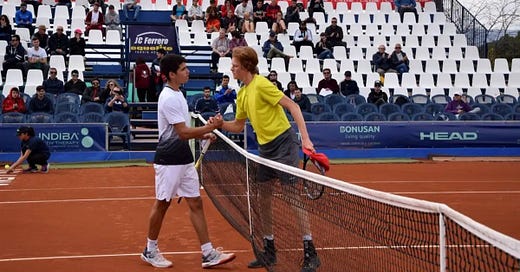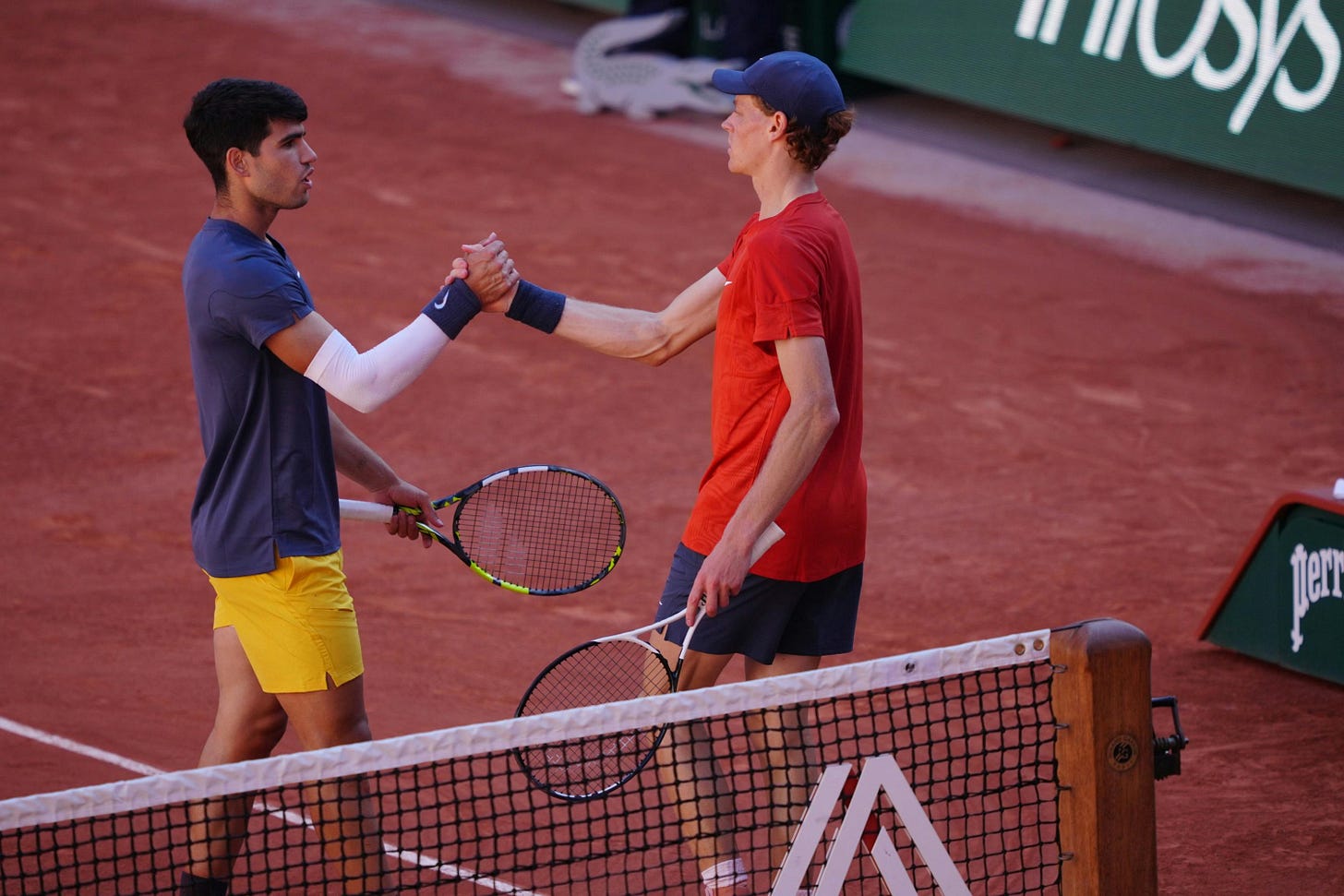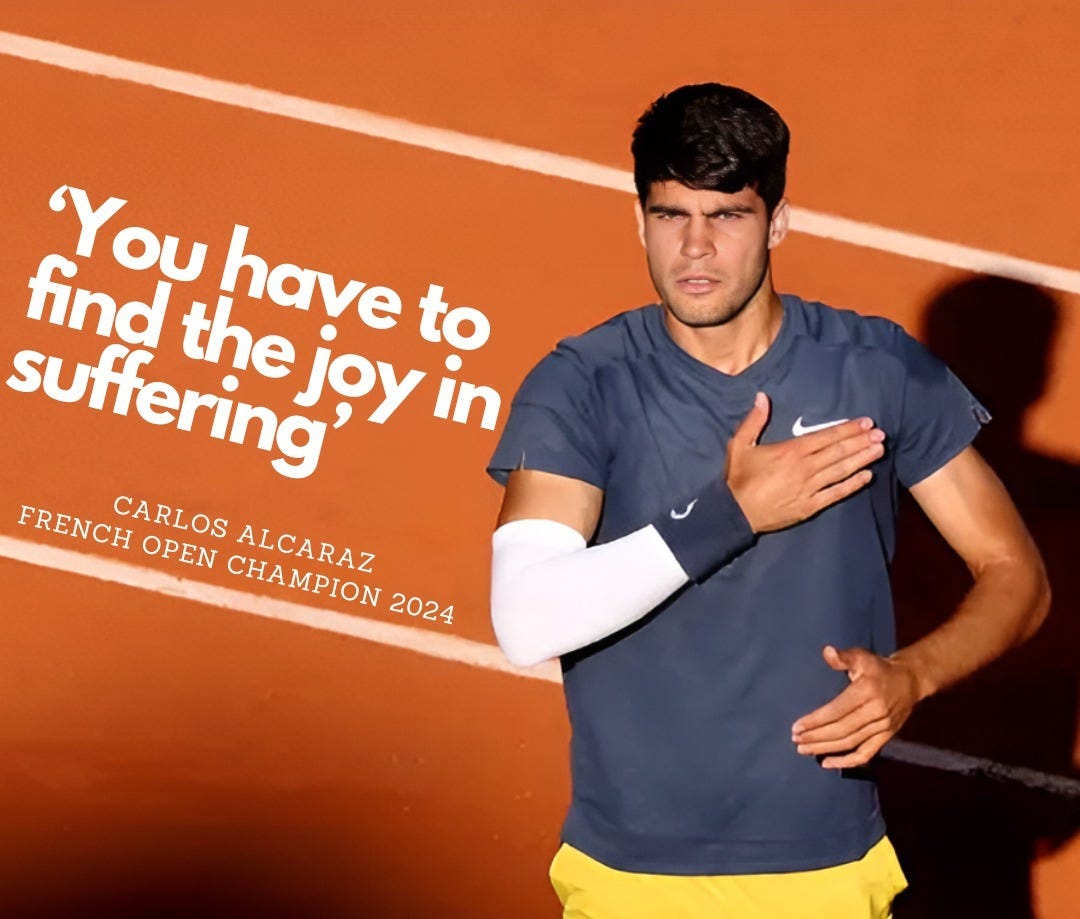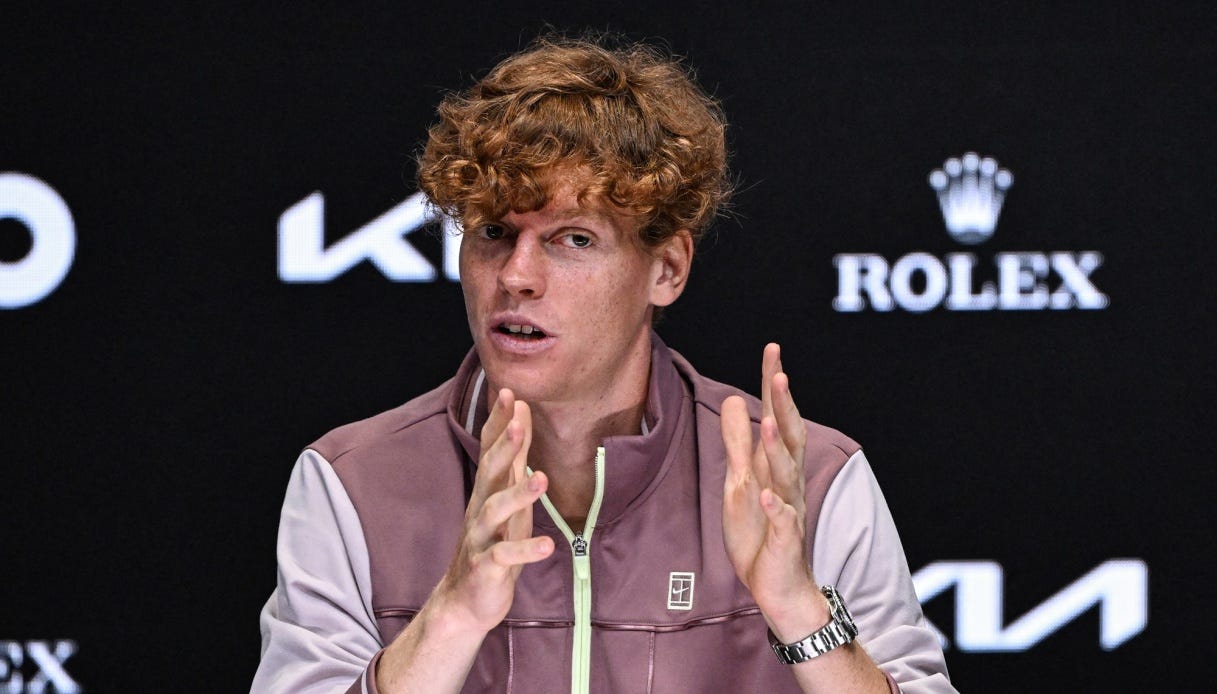The Night is still Young
If you win, you win. If you lose, you still win. There's no way you can lose.
The premier tennis matchup in the world is finally back after a seven-month hiatus, as the two best players on the planet — Carlos Alcaraz and Jannik Sinner — face off in their first-ever major final, at the Coliseum. Whether you're a fan of one, neither, or (boo!) both, you have to agree that this is the kind of match that stops the world and makes everything revolve around it.
Both players are healthy and playing well enough that we should be in for a blockbuster clash. Let the tennis gods deliver!
Match-up:
One thing that makes this matchup so compelling is its unpredictability. In their 10 encounters so far (6–4 to Alcaraz), we’ve seen it all — from nail-biters to blowouts, match point saves to bakery products.
Much has been made of Carlos winning all three of their meetings last year, even when Sinner was the best player in the world, and rightly so. But what many fail to realize is just how razor-thin the margins are in this rivalry, and how a single point can completely alter the outcome.
While this rivalry doesn’t seem overly surface-dependent, as shown by the fact that both players have beaten each other in conditions that typically favor the other (Alcaraz winning on indoor hard, and Sinner taking their lone grass-court meeting), if we're being objective, the three surfaces they played on in 2024: Indian Wells (a slow, high-bouncing hard court), Roland Garros (sea-level clay), and Beijing (a medium-slow hard court), all leaned in Alcaraz's favor.
That context makes his current edge more understandable, but it doesn't make future outcomes any more predictable.
Things to watch out for:
Serve-Return Dynamic:
Everything starts with this, and while this aspect of the matchup should, in theory, favor Sinner, it's actually been one of the key reasons Alcaraz has won their recent meetings.
Sinner has the better serve, that’s not up for debate. The return game is more nuanced: Sinner is more consistent on the first-shot return, while Alcaraz can be streaky but retrieves far more balls thanks to his reach, defense, and movement.
Yet in 2024, Alcaraz won more points on his first serve in two of their three matches. In the one match he didn’t, he still made 10% more first serves overall, which compensated for the lower win percentage. On clay, in particular, he caused Sinner real problems with his wide slider on the deuce court and his heavy kicker to the ad side.
His second-serve strategy was also clear: trust the kicker and jam Sinner on the deuce side, forcing several missed forehand returns, especially in the crucial fifth set.
For Sinner, the path is simple. He has the clearly superior serve in this matchup. His T-serve remains a cheat code (winning 76% of points at RG), and on second serves, he needs to continue mixing it up — using placement and variety to surprise Alcaraz, especially by targeting the body.
Overall, I give Sinner the edge in this department. But I would have said the same last year, and Alcaraz flipped that script with a couple of inspired performances that turned a potential weakness into a weapon.
The Weapons:
We arguably have the two best forehands in the game facing off in this match, but I’d still give Alcaraz the edge in that department, especially on clay. When it comes to the backhands, though, there’s a clear advantage for the Italian. He’ll be targeting the newly abbreviated Alcaraz backhand, which, so far this clay season, has been more of a liability than a weapon.
If there’s one player who can consistently target Alcaraz’s backhand with precision and powerful ball striking, it’s Sinner — who I also believe is currently the best baseliner in the world.
But when you add variety, touch, and pure shotmaking, I give the advantage to Carlos. Sinner’s variety, especially his droppers, looks sharper post-ban, but for me, this is still no contest: Sinner’s variety is good, but Alcaraz’s is the best in the world.
On natural surfaces, movement also goes to Carlos — not because Sinner is an average mover, but because Alcaraz is at least top three in the world in this department too. How much of that advantage he actually capitalizes on, though, is entirely up to him.
Tactics:
Carlos Alcaraz:
The biggest mystery for me in this match is whether Alcaraz will stick to his baseline returning strategy, which, in my opinion, would be the wrong move, especially on clay. At Roland Garros, although he mixed up his looks, most of his returns came from the back of the baseline, focusing on just getting the return in, using heavy groundstrokes, and working the point from there, rather than trying to steal time by camping at the baseline.
As for his groundstrokes, I’m once again hoping he starts by varying his spin profiles and ball heights, instead of the 2024 trend where he came out swinging hard, got punished in the first set, and only learned to adjust when the margin for error shrank to almost nothing.
Angled forehands and high cross-court forehands should be his bread and butter, with slices and drop shots mixed in whenever possible. On the backhand side, rather than playing a continuous loop of cross-court exchanges that often lead to errors or gifting short balls, he should look to change direction down the line whenever there’s an opening.
This is a risky strategy in theory, but it’s one that would keep Jannik honest and test his legs — which likely aren’t yet fully battle-hardened.
There are two ways Alcaraz can win this match: make it beautiful or make it ugly. His level this tournament hasn’t been solid enough for the former, so he’ll need to embrace the latter. Out-variety the better baseliner, add in a moonball here and there like he did in the RG final last year, defend using superior movement, push at key moments, and instead of blasting linear winners, play smart and make every shot count.
Jannik Sinner:
Stay composed and trust your superior floor to carry you through. Dictate the match tempo. Serve performance will be key, and he should look to return Alcaraz’s still work in progress serve aggressively, especially on the second serves. As I’ve mentioned before, the new serving motion seems to have reduced the effectiveness of Alcaraz’s most reliable second serve — the wide kicker.
Be comfortable in linear rallies, as no one beats you there, and frustrate Carlos by not giving him the opportunity to attack first.
This can be achieved by minimizing central balls to his forehand and taking control with changes in direction or injecting pace early. Two shots from Sinner in particular will be crucial, I feel: the backhand down the line and the running forehand crosscourt — both of which are up there with the best in the world.
Don’t let Alcaraz’s forehand become the defining shot of the match, and aim to keep the ratio of forehands to backhands hit by Alcaraz as close to one-to-one as possible.
The intangibles:
Often, these high-profile matches are decided before they’re even played — in the players’ minds. Both Alcaraz and Sinner are strong mentally, and I don’t think either is under extreme pressure here. That said, if I had to choose, the pressure might lean slightly more on Jannik Sinner.
Going 0-4 against an Alcaraz who isn’t even at his absolute best would be disheartening. Sinner is both the bookmakers’ and the home crowd favorite, and the clear number one player in the world. But then again, this is his sixth professional match in 3 months, so even if he loses, he has a cop out here with Alcaraz being too good of an opponent too early into his comeback.
For Alcaraz, he remains the more experienced player in these big moments, despite being a season younger. Many of the cracks in his performances last season were papered over by his invincibility against his generational rival. Lose this match, and that luxury disappears. This rivalry has shown that when one player wins a match, they usually back it up with another. Conversely to Sinner, losing to him now, when he is just 6 matches into his comeback, and probably the weakest physically and match practice wise he will ever be this year, will surely raise some questions, something which is never good ahead of a Slam, no less a Slam that you defend.
Prediction:
This rivalry is no longer the guaranteed classic it once was, but despite that, it has delivered the matches of the year for the past three seasons, from 2022 to 2024. I expect this to be their best clay-court battle yet, following a rather forgettable Umag final in 2022 and the hot-and-cold Roland Garros semi last year.
I anticipate a three-set thriller, with Sinner storming out to a one-set lead by playing his aggressive best to take the opening set. The crucial second set will hinge on Alcaraz waking up and realizing that, naturally, he is the better clay courter of the two. If that happens, I expect the match to go the distance, with Alcaraz ultimately having more gas in the tank and more reps this season to draw on for a hard-fought victory over his rival.
Prediction: Alcaraz in 3
Stats & Trivia:
Alcaraz will aim to become just the fourth player in the Open Era to win all three clay Masters titles and Roland Garros over the course of his career, following in the footsteps of Nadal, Djokovic, and Kuerten.
Jannik Sinner will be looking to claim his first big title on clay and extend his streak of 24 consecutive sets won against top-10 players.
This is the first clay-court match since 2022 in which Carlos Alcaraz is not the bookmakers’ favorite.
Sinner has won 40 of his last 41 matches, with his only loss coming against Alcaraz in Beijing.
See you hopefully after the match with a quick recap and my clay power rankings ahead of Roland Garros! Enjoy the match!








